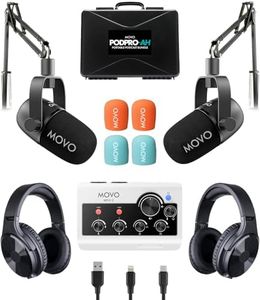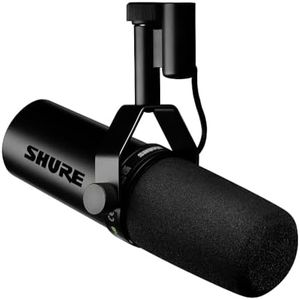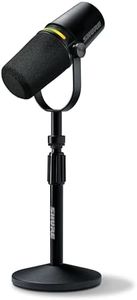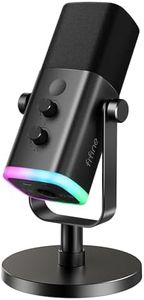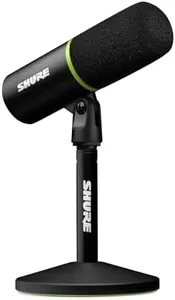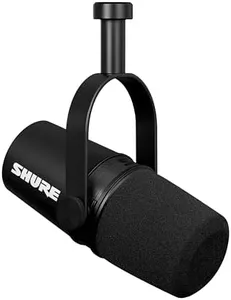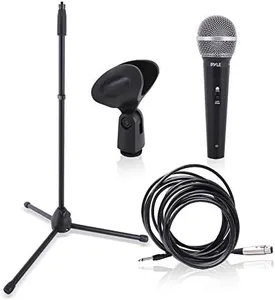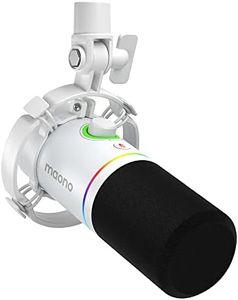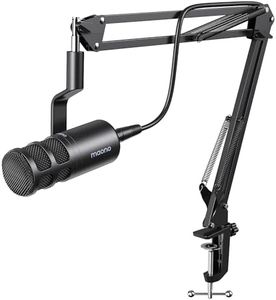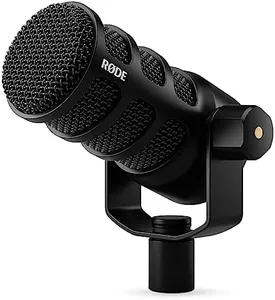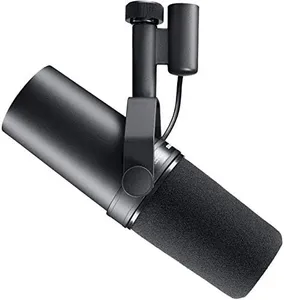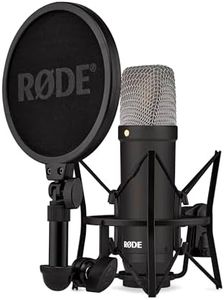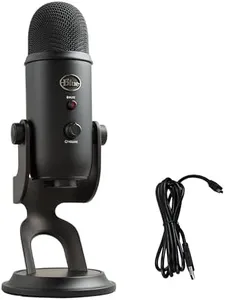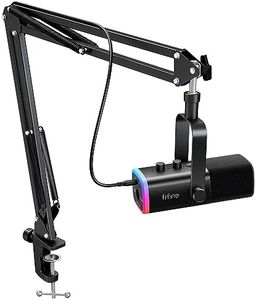10 Best Podcast Microphone 2025 in the United States
Our technology thoroughly searches through the online shopping world, reviewing hundreds of sites. We then process and analyze this information, updating in real-time to bring you the latest top-rated products. This way, you always get the best and most current options available.

Our Top Picks
Winner
Shure SM7dB Dynamic Vocal Microphone with Built-in Preamp – Studio Mic for Streaming, Podcasting, and Recording – Smooth Sound, Wide Frequency Range, Rugged Build, Windscreen Included, Black
Most important from
12436 reviews
The Shure SM7dB is a highly regarded dynamic microphone, particularly suited for podcasting, streaming, and recording. One of its standout features is its legendary sound quality, which delivers a warm and smooth tone that many broadcasters and content creators appreciate. With a built-in preamp offering adjustable gain levels of plus 18dB and plus 28dB, the SM7dB allows users to optimize their sound for various recording situations, whether that’s louder instruments or quieter vocals. This flexibility is a significant advantage for podcasters who may record in varying environments.
Its cardioid polar pattern excels at isolating voice and minimizing background noise, making it ideal for less-than-perfect recording spaces. The wide frequency response from 50 to 20,000Hz ensures detailed audio capture, allowing listeners to enjoy a rich sound experience. The microphone also includes switches that let users adjust the sound signature, catering to different voices or instruments, which adds to its versatility.
On the downside, the SM7dB requires 48V phantom power, which means it's not as plug-and-play as some USB microphones, potentially complicating setup for beginners. Additionally, while the build quality is rugged, it is somewhat heavier than some alternatives, which might be a consideration for those looking for portability. The price point is also on the higher side, which may not be suitable for all budgets.
Most important from
12436 reviews
Shure MV7+ Podcast Dynamic Microphone with Stand – OBS Certified, Enhanced Audio, LED Panel, USB-C & XLR Outputs, Auto Level Mode, Digital Pop Filter – for Podcasting, Streaming, and Recording, Black
Most important from
3729 reviews
The Shure MV7+ is a dynamic microphone designed specifically for podcasting, streaming, and recording, making it a great choice if you want clear, professional-quality audio without complicated setups. Its unidirectional (cardioid) polar pattern helps focus on your voice while reducing background noise, which is ideal for home studios or noisy environments. The mic’s build is sturdy metal, so it feels durable and reliable for regular use. Connectivity is very flexible, offering both USB-C and XLR outputs, so it fits beginner setups (just plug into your computer via USB) or more advanced professional gear with XLR. A standout feature is the LED touch panel that lets you mute instantly and customize colors, adding a fun and practical element during live streams.
The built-in digital pop filter and auto level mode adjust audio levels automatically based on how close you are to the mic, which means smoother and balanced sound without needing to tweak settings constantly. The advanced noise reduction and Shure’s Voice Isolation Technology work together to minimize background sounds like fans or echoes, helping your voice come through clearly. You can also add onboard reverb effects if you want a richer sound for music or creative projects. The MOTIV Mix app lets you fine-tune settings and customize the mic’s appearance, but it requires Windows 10 or macOS 12 and above.
One consideration is that while it offers many features, beginners might find the app and some settings a bit overwhelming at first. Also, it’s a bit heavier and bigger than some other podcast mics, which could be a factor if desk space is limited. The Shure MV7+ is well suited for podcasters and streamers seeking high-quality, versatile audio with easy-to-use smart features, especially if you want a mic that grows with your setup from beginner to pro.
Most important from
3729 reviews
FIFINE USB/XLR Dynamic Microphone for Podcast Recording, PC Computer Gaming Streaming Mic with RGB Light, Mute Button, Headphones Jack, Desktop Stand, Vocal Mic for Singing YouTube-AmpliGame AM8
Most important from
9023 reviews
The FIFINE USB/XLR Dynamic Microphone (AmpliGame AM8) is designed for versatile use in podcasting, gaming, and streaming. It offers both USB and XLR connectivity, making it suitable for beginners and more advanced users who want to upgrade their setup over time. The microphone features a unidirectional cardioid polar pattern, which helps in capturing clear audio while minimizing background noise. Its frequency response of 50Hz-16KHz ensures a balanced sound that is ideal for voice recording, although it might lack the depth needed for some musical applications.
The included mute button and RGB lighting with customizable options add convenience and visual appeal, particularly for gamers. However, these features are only available when using the USB connection. The microphone also comes with a desktop stand and has built-in threads for easy mounting on different stands, although the XLR cable and mic boom arm are not included. Build quality is solid, combining ABS plastic and durable metal, but it is somewhat bulky at 1.74 pounds.
The FIFINE AM8 is a great choice for those looking for a reliable and flexible microphone for podcasting, streaming, and gaming, but might not be the best option for professional music recording.
